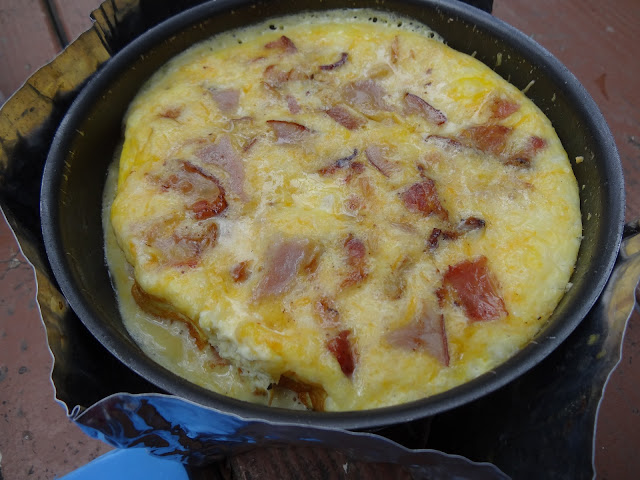Now the fact of the matter is that the burner head angles the flames outward which gives a well distributed flame. No "hot spotting" here.
 |
| The flame on a Kovea Spider is well distributed. |
First, the ingredients.
 |
| The makings of a nice omelette |
- Boxed milk of the type that needs no refrigeration.
- Some leftover bacon and ham
- Five eggs
- Some shredded cheese
- A bit of olive oil (to grease the pan)
 |
| The tools needed for cooking an omelette |
- MSR Blacklite pan (aluminum, not titanium or stainless steel)
- A Jetboil spatula
- A set of Open Country pot grippers
Well, then, let's crack the eggs.
 |
| Our eggs, laid out nicely in a bowl |
 |
| Milk makes for a really good omellete |
Next, beat the eggs and milk with a fork until well blended.
 |
| Beat the eggs and milk to as reasonably uniform a consistency as you can |
I then pour the blended eggs and milk into my pan which I have already greased with a bit of olive oil and sprinkle in the cheese.
 |
| Eggs in our pan with the cheese sprinkled on. |
Next, I break up a bit of bacon. Today I brought bacon cooked earlier that day, but a package of bacon bits from the market works quite well and is generally more practical for the trail.
 |
| Bacon, added to the mix |
 |
| Ham, added to the mix |
 |
| The Kovea Spider, legs deployed. |
I like to add a little disc of aluminum underneath. The aluminum disc will reflect heat upwards and also prevent any scorching of the picnic table I'm set up on. The disc doesn't come with the stove, but it's easy enough to buy or make one. The disc I have is from Flat Cat Gear and has a small hole punched out in the very center where the disk folds. This hole prevents tearing at the crease, which is a nice feature.
 |
| An aluminum disk reflects heat up to your pot and protects the surface you're working on. |
Recall also that one of the benefits of using a remote canister stove as opposed to the more typical upright canister stove is that you can use a fully enclosing windscreen. Use a full windscreen with an upright canister stove and your canister might just overheat and explode.
So! Eggs on, let's get cooking.
 |
| Cooking the omelette |
 |
| Eggs, just starting to bubble. |
Looks like things are coming along nicely. The toughest part of the omelette to get to cook properly is the very top. Here, I've pushed the edge of the omelette in a bit on the left hand side and allowed any remaining liquid eggs to flow into the resultant gap. Perhaps that's "cheating," but I look at that as being strictly a practical measure to ensure full cooking of that last little bit of liquid egg that always remains on top -- even when I cook omelettes at home.
 |
| Almost done now. |
 |
| The completed omelette. |
 |
| Looking at the omelette, edge on. |
Looking inside, I see that the eggs are fluffy and still moist but are definitely fully cooked. All of the cheese is fully melted and has made a nice topping.
 |
| A very nice omelette indeed! |
 |
| Sliced, the omelette holds a good ege and reveals it's fluffy inner texture. |
 |
| Flipping over a section of the bottom, we see a light browning. Looks good! |
 |
| No burnt on food on the pan. |
Personally, I find that a remote canister stove is a cook's stove, far more than any upright canister stove that I've used, including ones with larger burner heads. A remote canister stove permits the use of a full windscreen which allows me to use a very low flame without worrying about the flame being blown out. The windscreen also creates a very hot environment under that pan, and environment that allows me to have a lot more control over the heat of cooking than I would have with a typical upright set up which is open on the sides. A remote canister set up also gives me a very stable cooking platform with a lower center of gravity than an upright setup. I really like a remote canister set up if I want to do some real cooking.
Now, if you'll excuse me, I've got some eating to do.
I thank you for joining me on another Adventure in Stoving,
HJ
 |
| Time to eat. (it was most delicious, I assure you) |









0 comments:
Post a Comment